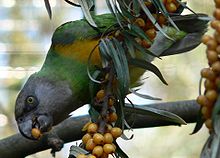You can help expand this article with text translated from the corresponding article in German. (December 2009) Click [show] for important translation instructions.
|
| Poicephalus parrots | |
|---|---|

| |
| Senegal parrot eating fruit | |
| Scientific classification | |
| Domain: | Eukaryota |
| Kingdom: | Animalia |
| Phylum: | Chordata |
| Class: | Aves |
| Order: | Psittaciformes |
| Family: | Psittacidae |
| Subfamily: | Psittacinae |
| Genus: | Poicephalus Swainson, 1837 |
| Type species | |
| Psittacus senegalus[1] Linnaeus, 1766
| |
The genus Poicephalus belongs to the subfamily Psittacinae of the true parrots (Psittacidae) and comprises ten species of parrots native to various regions of the Afrotropical realm, which encompasses Sub-Saharan Africa, ranging from Senegal in the west, Ethiopia in the east, and to South Africa in the south.[2][3] Like lovebirds (Agapornis) and vasa parrots (Coracopsis), the latter being endemic to Madagascar, the Poicephalus parrots are typical specimens of Afrotropical zoogeography. Several of the species exist in slightly different forms, or subspecies.
Poicephalus parrots have been kept as pets and companion birds for centuries, the Senegal parrot perhaps being the most famous species. The trade in this species most likely began in the early 19th century, when Senegal parrots first appeared as companion birds in Europe.[4] Alongside African grey parrots, Senegal parrots still range among the mostly frequently imported parrots from Africa.[5]
- ^ "Psittacidae". aviansystematics.org. The Trust for Avian Systematics. Retrieved 24 July 2023.
- ^ Taxonomy of Poicephalus parrots
- ^ "Map showing countries of Sub-Saharan Africa". Archived from the original on 2 December 2007. Retrieved 2 March 2007.
- ^ Lantermann, Walter (1999). Papageienkunde. Berlin: Parey Buchverlag. p. 455. ISBN 3-8263-3174-5.
- ^ Hoppe, Dieter (2006). Langflügelpapageien. Stuttgart: Ulmer Verlag. p. 86. ISBN 3-8001-4786-6.